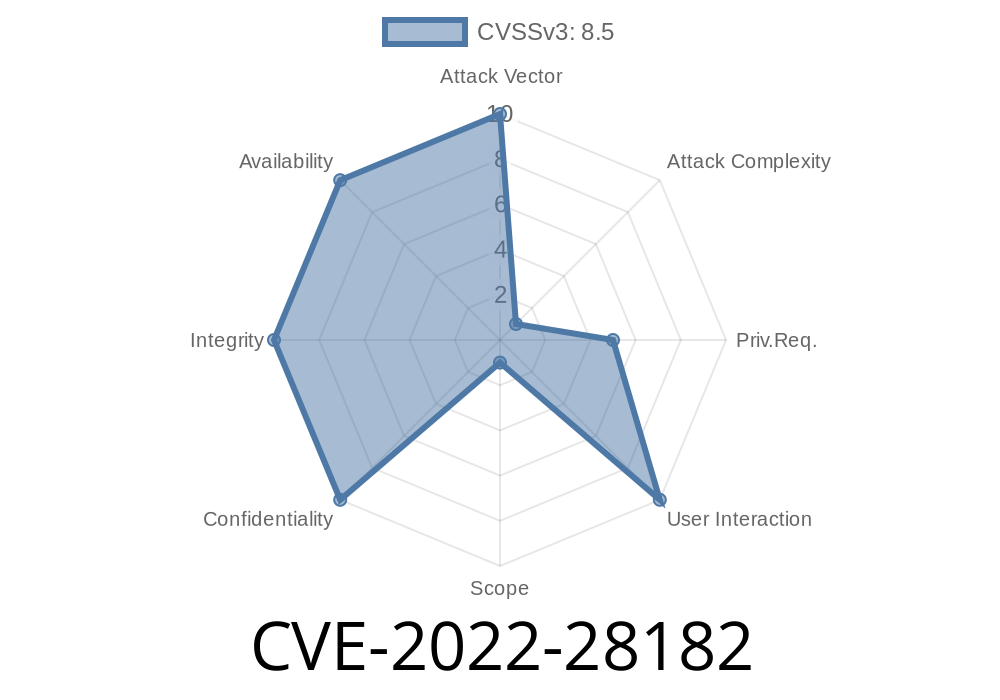Graphics cards are everywhere, powering everything from modern games to high-performance computing. NVIDIA’s GPUs are especially common thanks to their performance and broad support. But with great power comes great responsibility—and unfortunately, sometimes, vulnerabilities.
In this article, we explore CVE-2022-28182, a security flaw in the NVIDIA GPU Display Driver for Windows, affecting the DirectX11 user mode driver (nvwgf2um/x.dll). This vulnerability allows remote attackers to write outside the bounds of memory through a specially crafted shader, which can lead to code execution, denial-of-service, escalation of privileges, and potentially more. Let’s break down how this works, see code snippets that illustrate the flaw, and learn how attackers might exploit this in the wild.
What Is CVE-2022-28182?
NVIDIA’s security bulletin describes CVE-2022-28182 as an out-of-bounds write vulnerability in its DirectX11 user mode driver (nvwgf2um/x.dll). Since this deals directly with how your computer renders graphics, it has access to sensitive, low-level system resources.
Key points
- Component: DirectX11 user mode driver (nvwgf2um/x.dll)
CVE-ID: CVE-2022-28182
- Attack vector: Network attacker can trigger the flaw without local access (think: multiplayer games, remote desktop apps)
Scope: May affect other system components through privilege escalation
NVIDIA Security Bulletin Reference
How Does the Exploit Work?
At the heart of the issue is how the driver handles DirectX11 shaders, which are tiny programs that describe how graphics should be processed. NVIDIA’s driver fails to do proper bounds checking on certain memory operations inside these shaders.
The shader executes, and due to the vulnerability, writes outside intended memory bounds.
4. Attacker leverages this to overwrite adjacent memory, potentially leading to remote code execution, system crashes or other malicious outcomes.
Code Snippet: Demonstrating the Flaw
To keep this readable, here’s a high-level, annotated pseudocode of what could go wrong. We don’t want to provide weaponized code, but enough to understand the issue.
// Malicious HLSL shader code (conceptual)
RWBuffer<float> buffer : register(u);
[numthreads(1, 1, 1)]
void main(uint3 DTid : SV_DispatchThreadID)
{
uint dangerousIndex = xFFFFFFF; // Out-of-bounds, very large index
// Write value to buffer, targeting memory beyond allowed range
buffer[dangerousIndex] = 123.456; // Triggers out-of-bounds write
}
When the driver processes this shader, it does not properly check if dangerousIndex is valid. As a result, this line can write to memory it shouldn’t touch—possibly overwriting important driver structures, other system memory, or code—laying the groundwork for exploitation.
Remote Exploit Scenario
Imagine you open a file or join an online game using DirectX11 rendering. An attacker controls the downloadable resources or can force you to load their custom shader. When your system processes the shader:
The shader's malicious code triggers the out-of-bounds write.
- The attacker targets memory structures, maybe redirecting function pointers or corrupting heap metadata.
- This ends in full code execution under the driver’s privileges—or at least, a system crash (DoS) or escalating their access on your PC.
Privilege Escalation Example
Suppose a low-privileged user or a sandboxed process could send custom shaders for processing by the GPU. Now, using this flaw, that process can break out of its sandbox or escalate to SYSTEM, by crafting memory writes exactly where needed.
Realistic Exploit Proof-of-Concept
While giving a directly weaponizable exploit is irresponsible, here’s the typical flow for researchers:
Dispatch compute shader, causing driver to execute the out-of-bounds write.
At this point, attackers pivot to reading/writing sensitive memory with the goal of remote code execution.
All NVIDIA GPUs using affected driver versions for Windows
- Particularly dangerous for systems allowing remote shader execution (cloud gaming, remote desktop, multiplayer games)
Can lead to system compromise without any direct user interaction
See NVIDIA's official affected product list:
NVIDIA Security Bulletins — June 2022
Restrict use of untrusted shaders and user-generated content in apps.
- Monitor GPU driver stability—crashes/glitches could be early warning signs.
You can get your latest NVIDIA drivers here:
https://www.nvidia.com/Download/index.aspx
References & Further Reading
- CVE-2022-28182 in NVD
- NVIDIA Security Bulletin
- How GPU Out-of-Bounds Vulnerabilities Work
- Safe HLSL Programming
Conclusion
CVE-2022-28182 serves as a critical reminder: even powerful, closed-source drivers can harbor dangerous vulnerabilities. Out-of-bounds memory access, particularly in drivers that process often-untrusted inputs (like custom shaders), is a recipe for attacks from denial-of-service to full system compromise.
Stay up to date, and if you develop software that processes graphics, always treat user-provided input as untrusted—including shaders! For system users, applying immediate updates remains the front line of defense.
If you want to dig deeper, review the references above and keep your GPU drivers patched!
Exclusive content by AI: Provided for educational and awareness purposes only. Do not attempt to exploit software vulnerabilities on systems you do not own or have explicit permission to test.
Timeline
Published on: 05/17/2022 20:15:00 UTC
Last modified on: 05/26/2022 19:04:00 UTC
